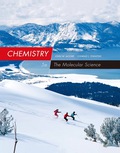
Concept explainers
(a)
Interpretation:
The fraction of chloride content in sample
Concept Introduction:
Chemical analysis is of two types: qualitative and quantitative. It gives the stoichiometry of constituent elements in a mixture or compound which basically depends upon the physical and chemical properties.
(a)
Explanation of Solution
Sample
Molar mass of
Mass of one mole of
Then, mass of chlorine in one mole of
Fraction of chlorine present in both the samples can be calculated as given below.
Therefore, the fraction of chloride content in sample
The samples can not be distinguished by means of chemical analysis. Because both
(b)
Interpretation:
The two X-ray diffraction results has to be interpreted in terms of the structures of the crystal lattices of sample
(b)
Explanation of Solution
In case of sample
In case of sample
(c)
Interpretation:
The chemical formula for sample
(c)
Explanation of Solution
The sample
From the X-ray diffraction studies, it has decided that two salts have been chemically reorganized into a new crystal. Hence, the chemical formula for sample
(d)
Interpretation:
The electrical conductivity of each
(d)
Answer to Problem 121QRT
The concentration of the ion
Explanation of Solution
Both the solution has been made by dissolving equal amount of each sample in
Molar mass of
Consider the chemical formula
Then,
Therefore, the concentration of the ion
Want to see more full solutions like this?
Chapter 9 Solutions
EBK CHEMISTRY: THE MOLECULAR SCIENCE
- Palladium has a cubic crystal structure in which the edge of the unit cell is 389 pm long. If the density of palladium is 12.02 g/cm3, how many palladium atoms are in a unit cell? In which of the cubic unit cells does palladium crystallize?arrow_forwardCalcium oxide consists of a face-centered cubic array of O2 ions, with Ca2+ ions at the center of the unit cell and along the centers of all 12 edges. Calculate the number of each ion in the unit cell.arrow_forwardThe unit cell of silicon carbide, SiC, is illustrated below. (a) In what type of unit cell are the (dark gray) C atoms arranged? (b) If one edge of the silicon carbide unit cell is 436.0 pm, what is the calculated density of this compound? A portion of the solid-state structure of silicon carbide.arrow_forward
- If an ionic solid has an fcc lattice of anions (X) and all of the tetrahedral holes are occupied by metal cations (M), is the formula of the compound MX, MX2, or M2X?arrow_forwardWhat is the coordination number of Cs in CsCl? of Na in NaCl? of Zn2 in ZnS?arrow_forward• describe the arrangement of atoms in the common cubic crystal lattices and calculate the packing efficiency for a lattice.arrow_forward
- Rutile, TiO2, crystallizes in a structure characteristic of many other ionic compounds How many formula units of TiO2 are in the unit cell illustrated here? (The oxide ions marked by an x are wholly within the cell; the others are in the cell faces.) Unit cell for rufflearrow_forwardA portion of the crystalline lattice for potassium is illustrated below. (a) In what type of unit cell are the K atoms arranged? A portion of the solid-state structure of potassium. (b) If one edge of the potassium unit cell is 533 pm, what is the density of potassium?arrow_forwardWhat is the coordination number in the cesium chloride cubic structure?arrow_forward
 Chemistry: The Molecular ScienceChemistryISBN:9781285199047Author:John W. Moore, Conrad L. StanitskiPublisher:Cengage Learning
Chemistry: The Molecular ScienceChemistryISBN:9781285199047Author:John W. Moore, Conrad L. StanitskiPublisher:Cengage Learning Chemistry: Principles and PracticeChemistryISBN:9780534420123Author:Daniel L. Reger, Scott R. Goode, David W. Ball, Edward MercerPublisher:Cengage Learning
Chemistry: Principles and PracticeChemistryISBN:9780534420123Author:Daniel L. Reger, Scott R. Goode, David W. Ball, Edward MercerPublisher:Cengage Learning Chemistry: Principles and ReactionsChemistryISBN:9781305079373Author:William L. Masterton, Cecile N. HurleyPublisher:Cengage Learning
Chemistry: Principles and ReactionsChemistryISBN:9781305079373Author:William L. Masterton, Cecile N. HurleyPublisher:Cengage Learning Chemistry & Chemical ReactivityChemistryISBN:9781337399074Author:John C. Kotz, Paul M. Treichel, John Townsend, David TreichelPublisher:Cengage Learning
Chemistry & Chemical ReactivityChemistryISBN:9781337399074Author:John C. Kotz, Paul M. Treichel, John Townsend, David TreichelPublisher:Cengage Learning Principles of Modern ChemistryChemistryISBN:9781305079113Author:David W. Oxtoby, H. Pat Gillis, Laurie J. ButlerPublisher:Cengage Learning
Principles of Modern ChemistryChemistryISBN:9781305079113Author:David W. Oxtoby, H. Pat Gillis, Laurie J. ButlerPublisher:Cengage Learning Chemistry & Chemical ReactivityChemistryISBN:9781133949640Author:John C. Kotz, Paul M. Treichel, John Townsend, David TreichelPublisher:Cengage Learning
Chemistry & Chemical ReactivityChemistryISBN:9781133949640Author:John C. Kotz, Paul M. Treichel, John Townsend, David TreichelPublisher:Cengage Learning





